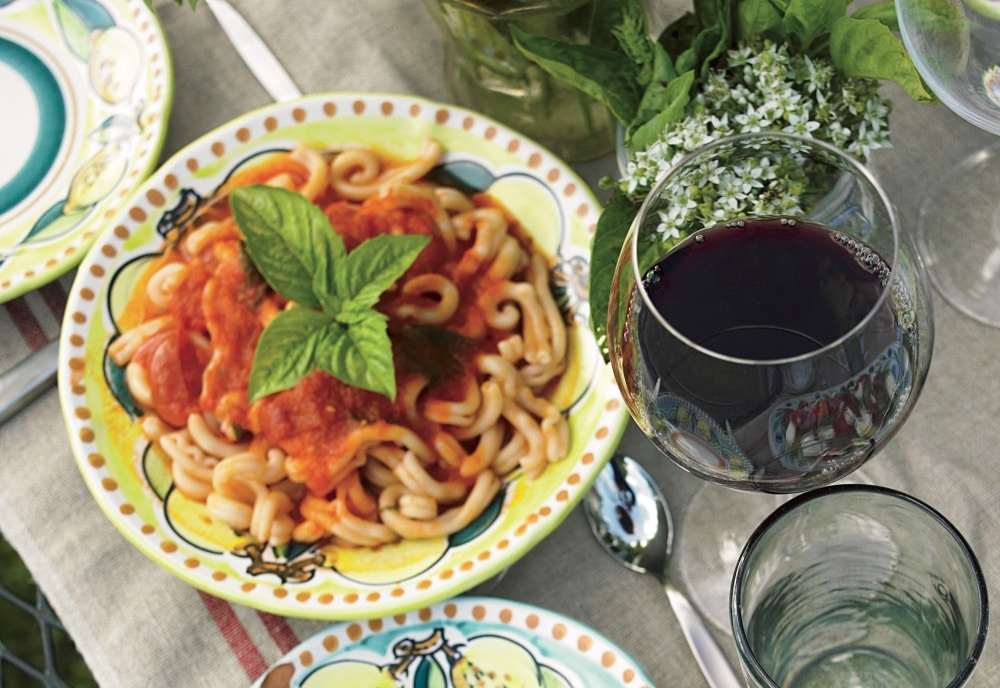
“Strozzapreti” translates as “priest chokers.” Many apocryphal tales explain this unusual term: Some say that insatiable priests were so enamored by this dish that they ate with such gluttony that they actually choked; other stories refer to the way the pasta is shaped, by rolling the dough over a skewer (or knitting needle), thus forming strips with enough force to “choke a priest.” Yet another legend says that hard-working peasants customarily make the pasta for churchmen in partial payment of their land rents, perhaps hoping they might choke on the food as revenge: unsavory stories for a delicate and delicious pasta that’s fun to make. If you don’t care to make this pasta from scratch, you can buy strozzapreti at your local grocery store, or substitute another favorite pasta shape if you prefer.
Yield:
10 servingsIngredients
1/2 cup semolina flour, plus extra if needed
1/2 cup all-purpose flour, plus extra if needed
1/2 teaspoon salt, plus extra for pasta water
2 large eggs
Tomato Sauce
3 tablespoons chopped fresh basil
1/4 cup (approx.) extra-virgin olive oil
1/2 cup (approx.) grated Parmigiano-Reggiano cheese
Instructions
In a large bowl, combine flours and salt. Mound flour mixture onto a wooden counter or cutting board and make a deep well in the center. Break eggs into the well and beat with a fork (without breaking the wall of flour). Begin mixing with your hands, gradually pulling in flour from the sides of the well’s wall to form dough.
Knead dough about 5 minutes, using lightly floured hands. This dough is not as dry as most pasta doughs; it should be moist but not sticky.
Lightly flour a dry kitchen towel (not terrycloth) and set aside. Scrape the wooden board clean. Using a wooden rolling pin dusted lightly with flour, roll dough out as thinly as possible into an approximate rectangle.
Score the rectangle into strips, each 1 inch wide and about 3 inches long. Wrap one strip lengthwise around a 1/4-inch-thick bamboo skewer or number 8 wooden knitting needle. The dough should fit tightly, with an overlapping visible seam.
Remove the skewer and place pasta on the floured towel. Repeat with remaining dough. Pieces should be irregular in size and shape. Let pasta dry at least 30 minutes or up to 24 hours. You may refrigerate it for up to 5 days, or freeze it until you’re ready to use it.
When pasta is dry and you’re ready to cook, bring a large pot of lightly salted water to a boil. Add strozzapreti to the pot and cook until tender, slightly chewy, and no longer raw in the center, about 8 minutes. (Strozzapreti will float to the surface; drain one piece, run it under cold water, and taste.) Drain cooked pasta and toss with Tomato Sauce over medium-high heat 1 minute. Remove from heat and toss with fresh basil and a drizzle of extra-virgin olive oil. Serve with grated Parmigiano-Reggiano at the table.
Tomato Sauce
Ingredients
3 tablespoons extra-virgin olive oil
2 garlic cloves, sliced in half
6 fresh basil leaves
2 cups Passata (or 1 16-ounce can peeled tomatoes passed through a food mill)
2 teaspoons kosher or sea salt
1 teaspoon red-pepper flakes
Instructions
In a large saucepot on medium setting, heat olive oil, garlic, and basil. Cook gently about 2 minutes, until fragrant; don’t brown. Raise heat to medium-high and add Passata (tomato puree), salt, and red-pepper flakes.
When sauce comes to a boil, reduce heat to low and simmer 30 to 35 minutes. Remove garlic cloves. Adjust seasoning to taste. Set aside until ready to use over pasta.
Passata
Ingredients
10 pounds ripe plum tomatoes
1 cup fresh basil leaves, plus 2 to 3 extra leaves per jar of sauce
1/4 cup kosher or sea salt


